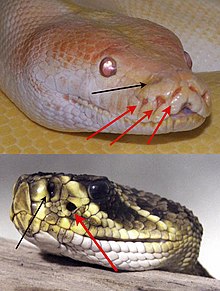
The ability to sense infrared thermal radiation evolved independently in three different groups of snakes, consisting of the families of Boidae (boas), Pythonidae (pythons), and the subfamily Crotalinae (pit vipers). What is commonly called a pit organ allows these animals to essentially "see"[1] radiant heat at wavelengths between 5 and 30 μm. The more advanced infrared sense of pit vipers allows these animals to strike prey accurately even in the absence of light, and detect warm objects from several meters away.[2][3] It was previously thought that the organs evolved primarily as prey detectors, but recent evidence suggests that it may also be used in thermoregulation and predator detection, making it a more general-purpose sensory organ than was supposed.[4][5]
- ^ Newman, EA; Hartline, PH (1981). "Integration of visual and infrared information in bimodal neurons in the rattlesnake optic tectum". Science. 213 (4509): 789–91. Bibcode:1981Sci...213..789N. doi:10.1126/science.7256281. PMC 2693128. PMID 7256281.
- ^ Goris, RC; Terashima, S (1973). "Central response to infra-red stimulation of the pit receptors in a crotaline snake, Trimeresurus flavoviridis". Journal of Experimental Biology. 58 (1): 59–76. doi:10.1242/jeb.58.1.59. PMID 4350276.
- ^ "Snake infrared detection unravelled". Archived from the original on 28 December 2016. Retrieved 20 January 2017.
- ^ Krochmal, Aaron R.; George S. Bakken; Travis J. LaDuc (15 November 2004). "Heat in evolution's kitchen: evolutionary perspectives on the functions and origin of the facial pit of pitvipers (Viperidae: Crotalinae)". Journal of Experimental Biology. 207 (Pt 24): 4231–4238. doi:10.1242/jeb.01278. PMID 15531644.
- ^ Greene HW. 1992. The ecological and behavioral context for pitviper evolution. In Campbell JA, Brodie ED Jr. 1992. Biology of the Pitvipers. Texas: Selva. 467 pp. 17 plates. ISBN 0-9630537-0-1.